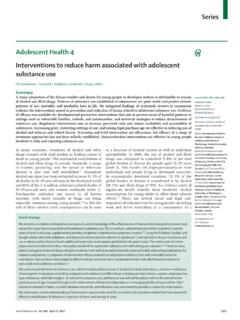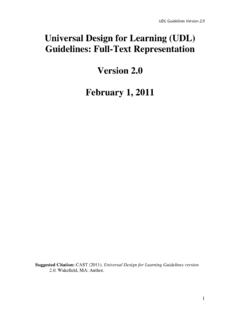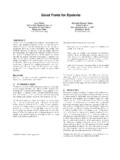Transcription of Inclusive Education for Students with Disability - ARACY
1 Inclusive Education for Students with DisabilityA review of the best evidence in relation to theory and practiceA What Works for Kids Evidence Review Prepared by The Australian research Alliance for Children and Youth ( ARACY ) Prepared for The Australian Government Department of Education , Employment and Workplace Relations. The views expressed in this publication do not necessarily represent the views of the Australian Government or the Department of Education , Employment and Workplace Relations. On 18 September 2013, Machinery of Government changes established the Department of Education and the Department of Employment out of the former Department of Education , Employment and Workplace Relations (DEEWR).
2 Any reference to DEEWR in this document should now be read as the Australian Government Department of Education . Authored by Professor Chris Forlin Chris Forlin Education Consultant Dr Dianne Chambers University of Notre Dame, Western Australia Professor Tim Loreman Concordia University, Edmonton, Canada Assoc. Professor Joanne Deppeler Monash University, Victoria Dr Umesh Sharma Monash University, Victoria Peer reviewed by Professor Tony Shaddock University of Canberra Assoc. Professor Ian Dempsey The University of Newcastle Assoc. Professor Michael Arthur-Kelly The University of Newcastle Coordinated by Adam Heaton and Angela Southwell ARACY Disclaimer: Data reported and the subsequent analyses are based on information gleaned from a variety of sources.
3 The authors have not attempted to validate these data and are unable to vouch for the authenticity of them. While all attempts have been made to include reference only to published sources through reputable journals, government publications, internationally accepted authorities, and Education system websites, the authors are not responsible for any misrepresentations obtained directly from these sources. Table of contents Executive Summary .. 4 Background: Inclusive Education definitions, concepts and measures .. 6 Definitions of inclusion .. 6 Concepts of inclusion .. 7 Conceptualising Inclusive Education based on key features.
4 7 Conceptualising Inclusive Education as the removal of that which excludes and marginalises .. 8 Measuring Inclusive Education .. 10 Overview of the evidence-base on Inclusive Education practices and policies for Students with Disability .. 15 Inclusive Education policy for Students with Disability : An international 15 International good practice in Inclusive Education .. 17 Current practice in Inclusive Education in Australia .. 20 Inclusive policies and available support services for Students with Disability in Australian states and territories .. 20 Inclusive practice in the government school sector across all Australian states and territories.
5 22 New South Wales .. 22 Victoria .. 23 Queensland .. 24 Australian Capital Territory .. 25 South Australia .. 25 Western Australia .. 26 Northern Territory .. 27 Tasmania .. 27 Educational outcomes currently being achieved by Students with Disability in Australia .. 28 Good practice in Inclusive Education in Australia .. 30 Good in-class practice .. 32 Analysis and conclusions .. 36 The Finnish Education system and its policy relevance to Australia .. 37 Suggestions for areas of further consideration to assist future policy development on good practice in Inclusive Education .. 40 Tension arising from the choice and equity debates.
6 41 Increased pressure to demonstrate improvement in academic outcomes .. 41 Acceptance of social and political changes in the school community .. 42 Aligning teacher Education programs with Inclusive Education policy initial teacher Education .. 42 Teacher Education as professional learning .. 43 References .. 44 Executive Summary This report was commissioned by the Australian research Alliance for Children and Youth ( ARACY ) for the Department of Education , Employment and Workplace Relations (DEEWR). Inclusive Education has been identified as a focus area for investigation, toward exploring what research has been found to work in improving not only school attendance but also school achievement and other learning outcomes for Students with Disability .
7 This report presents an overview of Inclusive Education in an international and Australian context. It provides an analysis of the current provision of Inclusive Education in the Australian government school sector, and will be complemented by a further review than analyses the current provision of Inclusive Education in the Australian non-government school sector. This report identifies research and evidence-based literature regarding outcomes of Inclusive Education for Students with Disability internationally, and specifically within Australia. An analysis and policy discussion is included of this evidence in regard to three key research questions: 1.
8 How is Australia sitting internationally in relation to the extent Students with Disability or additional learning needs can access and participate in Education on the same basis as Students without Disability ? 2. What are the Australian and international policies (that is the possibilities) for improving learning outcomes for Students with Disability or additional learning needs? 3. What programs are currently being implemented and what learning needs are they attempting to meet? To answer these questions data was obtained from a wide variety of key published sources including reputable peer reviewed journals, publicly available government publications, internationally accepted authorities and Australian Education system websites.
9 In excess of 150 individual data sources were reviewed, which form part of this synthesis. Australia, like most countries, views inclusion as a Disability issue, with almost all regions maintaining some form of separate special Education . Australia has joined other countries in a global effort to promote equal and active participation of all people with Disability , with the ratification of the United Nations Convention on the Rights of People with Disabilities in 2008. In relation to Education , the Convention states that persons with Disability should be guaranteed the right to Inclusive Education at all levels, regardless of age, without discrimination and on the basis of equal opportunity.
10 Australia s commitment is also reflected in the Disability Discrimination Act 1992 and in the establishment of the Disability Standards for Education 2005 (the Standards) that clarify and elaborate on legal obligations associated with Inclusive Education . All Education providers are required to be aware of and implement the Standards to enable Students with Disability receive an Education equal to that of any other student. The Government is, nonetheless, explicit in their support for Inclusive Education through policy that recognises the need for 5 interdisciplinary engagement and the provision of additional resourcing.



